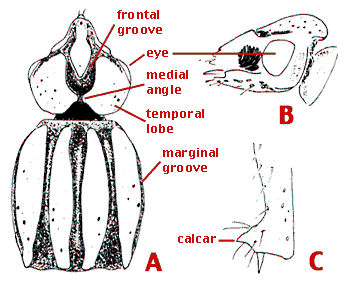Omoglymmius (Boreoglymmius)
Ross T. Bell- Omoglymmius lewisi
- Omoglymmius hamatus
- Omoglymmius americanus
Introduction
Boreoglymmius is a small subgenus with three species found in temperate North America and Japan.Characteristics
The antenna is without an apical stylet. Antennomeres V-X have basal setae. The clypeal setae are absent. The eye is large and normal for Rhysodini. It is deeper than long, and the cornea is facetted. The temporal setae are absent. The frontal grooves are deep and complete. The medial angles of the temporal lobes are simple, without emargination or translucent areas.


Omoglymmius (Boreoglymmius) americanus. (A) Dorsal aspect of head and pronotum. (B) Lateral aspect of head. (C) Apical portion of the male hind tibia. Modified from Bell and Bell (1982). Copyright © 1982 Ross T. Bell and Joyce R. Bell.
The marginal groove of the pronotum is deep and complete. The spur of the middle tibia is curved anteriorly. The punctures of the abdominal sterna III-V are scattered. The lateral pits of the female vary. Either they are shallow and restricted to sternum IV, or else they are deep and extend over sterna III and IV. The anterior femur of the male has a ventral tooth, and the hind calcars are larger than the middle ones.
References
Bell, R. T. and J. R. Bell. 1982. Rhysodini of the World Part III. Revision of Omoglymmius Ganglbauer (Coleoptera: Carabidae or Rhysodidae) and substitutions for preoccupied generic names. Quaestiones Entomologicae 18: 127-259.
Title Illustrations

Omoglymmius (Boreoglymmius) hamatus, California, U.S.A. Photograph copyright © 1997, David R. Maddison.
| Scientific Name | Omoglymmius hamatus |
|---|---|
| Location | California, U.S.A. |
| Specimen Condition | Live Specimen |
| Image Use |
 This media file is licensed under the Creative Commons Attribution License - Version 3.0. This media file is licensed under the Creative Commons Attribution License - Version 3.0.
|
| Copyright |
© 1997 David R. Maddison

|
About This Page
Ross T. Bell

University of Vermont, Burlington, Vermont, USA
Page copyright © 2000 Ross T. Bell
All Rights Reserved.
- First online 01 March 2000
Citing this page:
Bell, Ross T. 2000. Omoglymmius (Boreoglymmius). Version 01 March 2000 (under construction). http://tolweb.org/Omoglymmius_%28Boreoglymmius%29/2047/2000.03.01 in The Tree of Life Web Project, http://tolweb.org/








 Go to quick links
Go to quick search
Go to navigation for this section of the ToL site
Go to detailed links for the ToL site
Go to quick links
Go to quick search
Go to navigation for this section of the ToL site
Go to detailed links for the ToL site